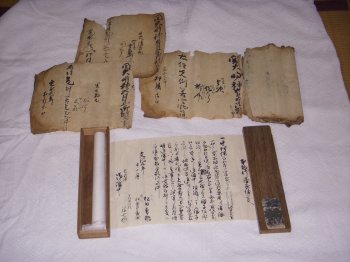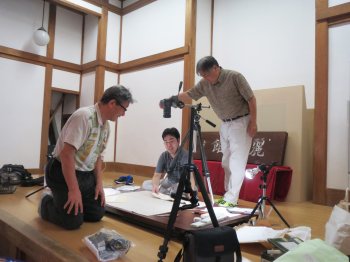Joint research project: Research and Analysis of the Fujii-Family Papers, a Priest Clan of Rikyu-Hachimangu Shrine, Oyamazaki, Kyoto
Geographical scope
Shimamoto Town Museum of History and Culture
Purpose
-
 Historical documents at Sekidaimyo Shrine
Historical documents at Sekidaimyo Shrine
-
 Photographing of materials (September, 2016)
Photographing of materials (September, 2016)
The Fujii Noritomo Family lineage of Shinto priests is believed to trace back to the Muromachi Era (1336 – 1573), originating from the Usa Hachimangu Shrine in Kyushu. Throughout the early modern period, the family was involved in the management of the Rikyu Hachimangu Shrine and its territory, Oyamazaki Manor. The findings of past research on the Oyamazaki district and Rikyu Hachimangu in the early modern and modern periods have been compiled in The History of the Rikyu Hachimangu (Sogoro Uozumi, Kozo Sawai), The History of Oyamazaki (Ichiro Yoshikawa), The History of Oyamazaki Town as well as The Comprehensive Study of Oyamazaki Manor in Yamashiro Province I, II (ISJFC Oyamazaki Research Project). Meanwhile, documents found in the recent study have never been used or published in previous research.
Particularly notable are the Fujii Family Papers. At the beginning of the modern era, Oyamazaki Manor in Yamashiro Province, which belonged to Rikyu Hachimangu, was divided at the boundary of Sekidaimyo Shrine. The western area became part of Osaka Prefecture (Yamazaki Village → Shimamoto Town), while the eastern area was incorporated into Kyoto Prefecture (Oyamazaki Manor → Oyamazaki Town). The Fujii Family Papers are the first comprehensive documents known to have been passed down in a priest family in the western area.
The papers are expected to cast light on the reorganization of the Rikyu Hachimangu Shrine during the period of major change at the end of Japan’s feudal era from the standpoint of the former Yamazaki Village.


